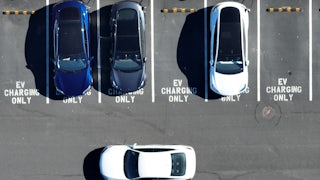The Supreme Court is on summer vacation. It’s been a busy couple of years for the justices: In just the last two terms, the court’s resurgent conservative majority has overturned Roe v. Wade, expanded the Second Amendment’s protections for gun ownership, struck down the Biden administration’s plan for student debt relief, eliminated affirmative action in college admissions, and rejected the independent state legislature theory. While the court often makes history, it rarely makes so much so quickly.
The upcoming term’s docket doesn’t have as many high-profile cases at the moment. But in two notable instances, the justices are poised to tackle another conservative legal movement priority: reshaping the relationship between Congress, the executive branch, and the federal regulatory agencies they oversee. Along the way, the justices might also upend the balance of power between the courts and the elected branches of government.
The court has already scheduled one of the cases for oral argument. In early October, the justices will hear arguments in Consumer Financial Protection Bureau v. Community Financial Services Association of America. (I’ll refer to it as “the CFPB case” hereafter for brevity’s sake.) At issue is whether the CFPB’s funding structure is unconstitutional. As I noted in February when the court agreed to hear the case, it is an existential threat to both the agency itself and to the work it has done to enforce federal consumer protection laws since its 2010 creation.
Most federal agencies are funded by periodic congressional budgetary appropriations. The CFPB is not. Congress established it as part of the Great Recession–era Dodd-Frank reforms to Wall Street to enforce consumer protection laws for banks, mortgage companies, payday lenders, and so forth. Lawmakers accordingly structured the agency more like a financial regulator in order to insulate it from political interference: Congress funded the bureau by setting a capped amount of money it could draw from the Federal Reserve’s revenue each year. Congress still has the power to adjust the cap, do away with it altogether, or make any other changes it wishes to the CFPB’s structure with future legislation.
The payday-lending industry brought the suit in order to challenge CFPB-issued rules that protect its customers from excessive overdraft fees. The industry argued that the bureau’s unusual funding structure violates the Constitution’s separation of powers. Since the agency’s structure is unconstitutional, the payday lenders argued, so too are the rules and regulations it has imposed since its creation. That argument persuaded the Fifth Circuit Court of Appeals, where a conservative three-judge panel last year declared the CFPB to be unconstitutional.
“An expansive executive agency insulated (no, double-insulated) from Congress’s purse strings, expressly exempt from budgetary review, and headed by a single Director removable at the President’s pleasure is the epitome of the unification of the purse and the sword in the executive—an abomination the Framers warned ‘would destroy that division of powers on which political liberty is founded,’” Judge Cory Wilson wrote for the panel.
Describing a consumer protection agency as an “abomination” might seem bizarre to a casual observer, but it fits within a broader pattern of how the conservative legal movement has demonized the CFPB since its creation. Justice Brett Kavanaugh rose to prominence in right-wing legal circles—and, arguably, to the Supreme Court itself—for writing a 2018 dissent on the D.C. Circuit where he denounced the provision in the law establishing the CFPB that attempted to politically insulate the bureau’s director by mandating that they could only be fired for cause (“inefficiency, neglect of duty, or malfeasance in office”) rather than at the president’s pleasure. The Supreme Court ultimately struck down that provision two years later.
Republican lawmakers, including those with deep ties to the industries regulated by the CFPB, have also often criticized the agency. In a hearing last month, Pennsylvania Representative Dan Meuser told CFPB Director Rohit Chopra that he had talked with a variety of banks ranging from local institutions in his state to “big guys” on Wall Street, “and they’re really not happy with your agency.” He urged Chopra to listen to the banking industry’s concerns and “be responsive to the clientele that you’re supposed to be helping” when drafting regulations. “Just to be clear, the clientele of the CFPB is not banks,” Chopra replied. “The clientele is the public.”
The CFPB, for its part, argued in its brief for the court that Congress has long adopted unusual funding structures for federal agencies. The Constitution itself only requires regular appropriations for the armed forces, it noted, by specifically forbidding any funding “for a longer term than two years.” That restriction reflected the Framers’ fear of standing armies as a threat to liberty, a concern that was itself rooted in their English forefathers’ experiences during the Cromwellian era.
Beyond that narrow prohibition, Congress has long adopted similar funding systems when lawmakers felt it necessary, the CFPB argued. Early Congresses made lump-sum appropriations to the early federal government, leaving it up to the president to fill in the details while setting a cap on what he could spend. Congress has often made standing appropriations that aren’t subject to periodic renewal, most notably for Social Security payments. And it allowed budgeting through indirect sources: Lawmakers in the early republic initially funded the Post Office, the Mint, and the Patent Office through fees for their services, not through regular appropriations.
The payday-lending industry disputed that historical evidence and the CFPB’s interpretation of it. It argues in its own brief that the CFPB is some sort of unique threat to American liberty, one that requires a narrower interpretation of the Appropriations Clause and an end to more imaginative approaches to building federal agencies. This viewpoint is likely to find a receptive audience in October. The conservative justices have treated the agency’s overall structure with skepticism and hostility in past cases, and they may be inclined to do so again in the CFPB case.
The other case before the court is about who decides when federal agencies can use their powers. In Loper Bright Enterprises v. Raimondo, the court appears ready to overturn or at least seriously narrow the Chevron doctrine. While somewhat obscure to the general public, Chevron is one of the most influential precedents when it comes to regulatory power. The doctrine is named for a 1984 case that challenged the Environmental Protection Agency’s reinterpretation of a vague provision of the Clean Air Act. In its ruling, the Supreme Court ruled that federal courts should defer to agencies’ readings of statutes that authorize them to regulate something when the statute in question is unclear.
“If the intent of Congress is clear, that is the end of the matter; for the court, as well as the agency, must give effect to the unambiguously expressed intent of Congress,” Justice John Paul Stevens wrote for the court. “If, however, the court determines Congress has not directly addressed the precise question at issue, the court does not simply impose its own construction on the statute.” Courts should defer, he wrote, if the agency’s reading is “based on a permissible construction of the statute.”
As I’ve noted before, the Chevron court grounded its ruling in a pragmatic approach to modern American government as well as a sense of judicial humility. Experts at federal agencies are better positioned to decide what counts as a “source” of pollution under the Clean Air Act, to take one example, than federal judges with no formal scientific training. Those agencies are also answerable to the president and accountable to Congress—and therefore ultimately responsible to the American people—while unelected judges are not.
A host of conservative judges and legal scholars have over the years strongly disagreed with that approach to judicial power. They often argue that it is the courts’ inherent responsibility to interpret the scope of federal laws. Deference, they claim, is unwarranted when agencies take maximalist approaches to their own legal authority. This view also dovetails with the conservative legal movement’s overall skepticism of what they call “the administrative state,” a somewhat pejorative term for federal agencies that have the power to issue rules and regulations. (Agencies like the EPA and the Food and Drug Administration are considered to be part of it; NASA and the Postal Service are generally not.)
Loper Bright involves a challenge to one of the lesser-known federal agencies: the National Marine Fisheries Service, which is charged with protecting fisheries in American waters from overfishing and other long-term threats. The NMFS added a monitoring program for Atlantic haddock in a 2020 rule change to determine if that species was being overfished. Since NMFS officials cannot speak directly to Atlantic haddock, the program placed observers on commercial fishing vessels to monitor their catches at industry expense. Loper Bright, a commercial fishing company, recognized the agency’s well-established power to place observers but challenged the requirement that it be done at the company’s expense. The agency defended itself by pointing to vague language in the 1976 statute in question.
The fishing company lost in the lower courts, prompting it to ask the Supreme Court to intervene. It presented two questions for the justices to resolve. The first asked whether the lower courts had properly applied the Chevron doctrine when interpreting the law in question. The other requested the court overturn Chevron altogether or “at least clarify that statutory silence concerning controversial powers expressly but narrowly granted elsewhere in the statute does not constitute an ambiguity requiring deference to the agency.” When the court agreed to hear the case in May, it only took up the second question, putting Chevron in the firing line.
It is hard to imagine that the court won’t move against Chevron since a majority of its current members have criticized it to varying degrees. The question is how far they’ll go. While Chevron is controversial in conservative legal circles, it is also one of the most widely cited cases in the lower courts, and overturning it outright could lead to judicial chaos. For that reason, some administrative law scholars think that the court will simply defang Chevron by narrowing what counts as an “ambiguity” in a statute. (In this case, that could mean ruling that a statute’s silence on something can’t be interpreted as permission to do it.)
Indeed, the court has already largely sidestepped Chevron in its own recent rulings, opting instead to use tools like the “major questions doctrine” in recent terms to block disfavored rules and regulations. That inclination itself—to skip Chevron guidance in favor of the newer major questions approach—is likely a sign that Chevron is not long for this world. Another case this term, SEC v. Jarkesy, could also give the court’s conservative justices a chance to revivify the nondelegation doctrine. Strengthening the judiciary’s power to decide when Congress delegates too much authority to federal agencies would also give it another mechanism to curb federal agencies.
These cases aren’t on their respective faces as exciting as some of the recent disputes that have come before the court. Nor are they likely to evoke the same passions among the American people as cases on abortion rights, gun ownership, or affirmative action. But they could still have broad implications for American democracy itself. If the justices nix Chevron deference or limit Congress’s appropriations power, the result won’t be a more harmonious balance between legislative and executive power. It will be the continued accumulation of judicial power to decide how and when the elected branches of government can govern.










